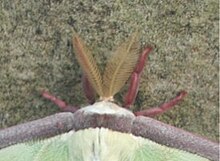| Revision as of 02:10, 20 July 2005 editBAxelrod (talk | contribs)Extended confirmed users769 editsm fix other uses← Previous edit | Revision as of 09:12, 31 August 2005 edit undoYurikBot (talk | contribs)278,165 editsm robot Adding: ukNext edit → | ||
| Line 11: | Line 11: | ||
| ] | ] | ||
| ] | ] | ||
| ⚫ | ] ] | ||
| {{Invertebrate-stub}} | {{Invertebrate-stub}} | ||
| ⚫ | ] | ||
| ] | |||
| ] | |||
Revision as of 09:12, 31 August 2005
For other uses, see the Antenna disambiguation page.
Antennae (singular antenna), are the paired appendages connecting to the first (and in crustaceans also to the second) segment of the head of the members of all subphyla of the arthropods except Chelicerata. Also the members of the order protura lack them.

Antennae are jointed, and in crustaceans branching, they generally extend forward of the animal and are known to be sensory organs, although the exact nature of what they sense and how they sense it is often not entirely clear. It appears that their function can include sensing of any or all of touch, air motion, heat, vibration (sound) and olfaction (smell/taste).
In insects olfactory receptors on the antennae express bind to odor molecules and pheromones. The neurons that express these receptors signal this binding by sending action potentials down their axons to the antenna lobe in the insect brain. From there, neurons in the antenna lobe connect to mushroom bodies that identify the odor.
This animal-related article is a stub. You can help Misplaced Pages by expanding it. |